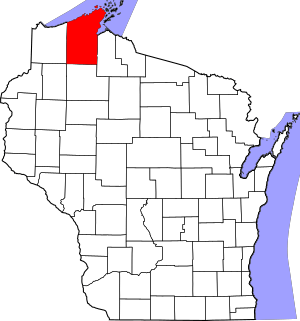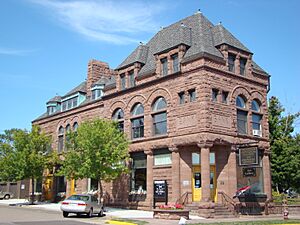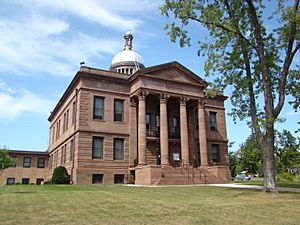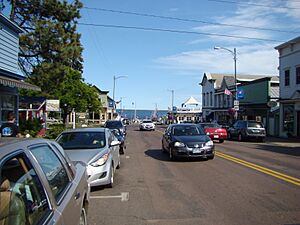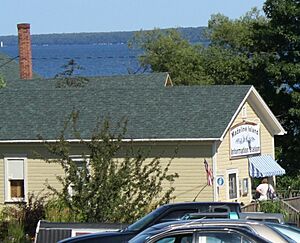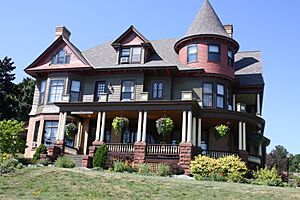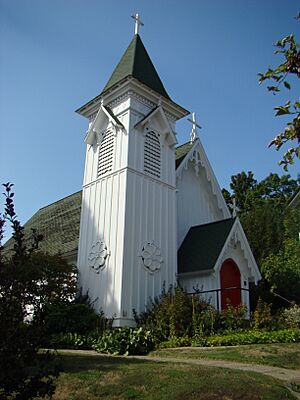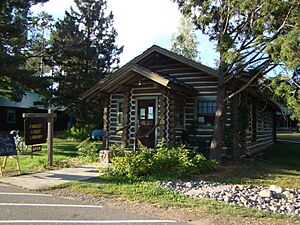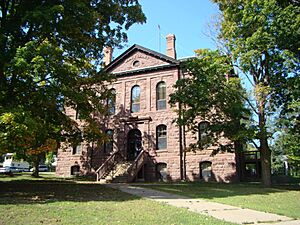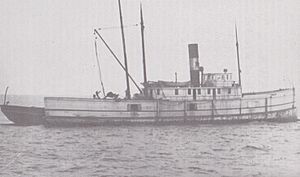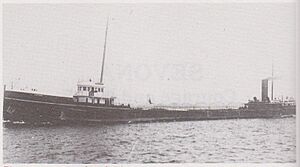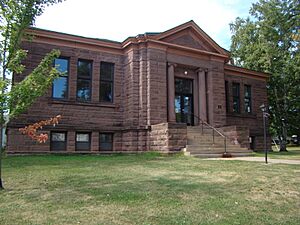National Register of Historic Places listings in Bayfield County, Wisconsin facts for kids
Welcome to Bayfield County, Wisconsin! This area is full of amazing history, and many of its special places are listed on the National Register of Historic Places. This is like a national "hall of fame" for buildings, sites, and objects that are important to American history, architecture, archaeology, engineering, or culture. When a place is on this list, it means it's recognized for its unique story and value.
In Bayfield County, there are 26 different places and areas that have made it onto this important list. These sites help us learn about the past, from old lighthouses that guided ships to historic homes and community buildings. Let's explore some of these cool historic spots!
Contents
- Historic Places in Bayfield County
- Apostle Islands Lighthouses
- Bank of Washburn
- Bayfield County Courthouse
- Bayfield Fish Hatchery
- Bayfield Historic District
- Booth Cooperage
- Frank Boutin, Jr. House
- Christ Episcopal Church
- East Third Street Residential Historic District
- Forest Lodge
- Forest Lodge Library
- Herbster Community Center
- Hokenson Fishing Dock
- Island Lake Camp
- Lake Owen Archeological District
- Old Bayfield County Courthouse
- OTTAWA (Tug) Shipwreck Site
- John and Justina Palo Homestead
- Pureair Sanatorium
- SEVONA (Bulk Carrier) Shipwreck Site
- Sevona Cabin
- Shaw Farm
- Washburn Public Library
- West Bay Club
Historic Places in Bayfield County
Apostle Islands Lighthouses
Imagine guiding ships through tricky waters! The Apostle Islands Lighthouses are six different lighthouses built on islands like Michigan, Raspberry, Outer, Sand, and Devils Islands. The oldest one was built way back in 1856. These tall, guiding lights helped ships safely navigate around the many islands in Lake Superior.
Bank of Washburn
The Bank of Washburn is a grand building in the city of Washburn. It was built in 1890 and designed in a style called Romanesque Revival. The building is made from brownstone, a type of reddish-brown sandstone, which was quarried right near Washburn. Today, this historic bank building is home to a museum and a cultural center.
Bayfield County Courthouse
Also in Washburn, the Bayfield County Courthouse was built in 1894. It features a Neoclassical Revival style, which means it looks like ancient Greek and Roman buildings. Like the Bank of Washburn, it's made from local brownstone. This building has served as the center of local government for over a century.
Bayfield Fish Hatchery
The Bayfield Fish Hatchery is a special place where fish eggs were raised. A private fish hatchery operated here from the 1860s. In 1895, the land was given to the state of Wisconsin, and a new hatchery was built. The main building has a unique gambrel roof and a Victorian style. It once held offices, living spaces, and an area for growing fish eggs, all using water from Birch Run Creek.
Bayfield Historic District
The Bayfield Historic District is a large area in the city of Bayfield that covers about 60 blocks. It's like stepping back in time! You can see many different kinds of buildings here, from old wooden shops to grand homes built in the Queen Anne style. It shows how the city grew and changed over the years.
Booth Cooperage
The Booth Cooperage in Bayfield was built around 1900 as a storehouse for fish. In 1914, it became a factory where skilled workers called "coopers" made wooden barrels by hand. They could make up to 75,000 barrels a year! These barrels were used to pack salted fish caught in the area.
Frank Boutin, Jr. House
The Frank Boutin, Jr. House is a beautiful home built in 1908 in the Queen Anne style. It has a mix of materials on its outside, including sandstone, brick, and clapboard siding. Frank Boutin, Jr.'s father was an important person in Bayfield's early days, working in the lumber and fishing industries.
Christ Episcopal Church
The Christ Episcopal Church in Bayfield is a very old church, with its chapel built in 1870. It was the first Episcopal church in northern Wisconsin. The church is built in a style called Carpenter Gothic, which uses wood to create designs often seen in stone Gothic cathedrals. It has a distinctive board and batten exterior.
East Third Street Residential Historic District
This historic district in Washburn includes 31 homes built between 1885 and 1950. You can see many different architectural styles here, like Colonial Revival, Queen Anne, Prairie School, and Craftsman. Some of these houses were even built by the DuPont company for their employees who worked at the Barksdale explosives plant nearby.
Forest Lodge
Forest Lodge is a rustic retreat located on Namekagon Lake in Namakagon. It was once a logging camp and later became a summer getaway for the Livingston/Griggs family from St. Paul. Buildings here were constructed from 1893 to 1950, including the main lodge, a two-story boathouse, and a maid's cabin. It's a great example of rustic architecture.
Forest Lodge Library
The Forest Lodge Library in Cable is a charming log building. It was built in 1925-1926 by Mary Livingston Griggs, a socialite from St. Paul. She built it for the community of Cable to honor her mother and their family lodge on Namekagon Lake. It's another wonderful example of rustic log cabin style.
Herbster Community Center
The Herbster Community Center is a town hall, gymnasium, and community center all in one. It was built in 1939-1940 in a rustic style as part of a WPA project. The WPA was a government program during the Great Depression that created jobs by building public works.
Hokenson Fishing Dock
The Hokenson Fishing Dock is located north of Bayfield at Little Sand Bay. It was built in 1927 by three brothers, the Hokensons, who were independent fishermen. They ran their fishing and packing business from Sand Island from the 1920s to the 1950s. The dock was built on "crib piers," which are wooden structures filled with rocks.
Island Lake Camp
Island Lake Camp is a rustic log cabin built in 1888 in Drummond. It was a summer retreat for the McCormick family and Dr. William Gray, who was a newspaperman and editor of a Presbyterian publication called "The Interior."
Lake Owen Archeological District
The Lake Owen Archeological District is a special area near Drummond that is protected because of its archaeological importance. This means it contains clues and artifacts from past human activity, helping us understand how people lived long ago.
Old Bayfield County Courthouse
The Old Bayfield County Courthouse in Bayfield was built in 1884 from local brownstone. It has elements of both Neoclassical and Romanesque Revival styles. It served as the county courthouse until 1892, when the county seat moved to Washburn. Over the years, it's been used as a school, a German prisoner-of-war camp, a community center, and a warehouse. Today, it's the headquarters for the Apostle Islands National Lakeshore.
OTTAWA (Tug) Shipwreck Site
The shipwreck site of the tugboat OTTAWA is located on the northern edge of Red Cliff Bay. The OTTAWA was a 151-foot tugboat built in Chicago in 1881. It used to tow huge rafts of logs across Lake Michigan. In November 1909, after helping another ship, it mysteriously caught fire one night, burned, and sank.
John and Justina Palo Homestead
The John and Justina Palo Homestead in Oulu includes a log house and other buildings, like a sauna. These were built between 1910 and 1949 by Finnish immigrant farmers. It shows how early settlers lived and worked in the area.
Pureair Sanatorium
The Pureair Sanatorium, located south of Bayfield, was built between 1918 and 1923. It was a hospital for people with tuberculosis (TB), a serious lung disease. Before antibiotics were discovered, treatment for TB involved isolation, rest, and fresh air. It was also called the "Tri-County Sanatorium" because it served Bayfield, Ashland, and Iron counties.
SEVONA (Bulk Carrier) Shipwreck Site
The shipwreck site of the SEVONA is north of Sand Island. The SEVONA was a 372-foot steel steamer built in 1890. On September 2, 1905, it was caught in a powerful storm (a "nor'easter") while carrying 6,000 tons of iron ore. It tried to find shelter near the Apostle Islands but ran aground on shoals north of Sand Island. Sadly, seven people died, but 16 managed to escape in lifeboats.
Sevona Cabin
The Sevona Cabin is located on Sand Island, north of Bayfield. This cottage was partly built using materials salvaged from the nearby SEVONA shipwreck. It was built in memory of the ship by Samuel Fifield, a businessman and lieutenant governor of Wisconsin.
Shaw Farm
The Shaw Farm is also on Sand Island. Francis Shaw received this land for his service in the American Civil War and built a cabin here in 1871. This was the first permanent home on the island. For 50 years, Francis and his family fished, farmed, and later ran a workshop and a store, making their farm the social hub of the island.
Washburn Public Library
The Washburn Public Library is a beautiful building designed in the Neoclassical style and built in 1904. It's a "Carnegie library," meaning it was built with money donated by Andrew Carnegie, a famous businessman who funded many libraries across the country. This library is still in use today!
West Bay Club
The West Bay Club is a rustic-styled clubhouse on Sand Island. It was designed by Buechner & Orth and built in 1913. It was originally created as a retreat for people from St. Paul, Minnesota, who suffered from hay fever and sought relief in the fresh air of the islands.


